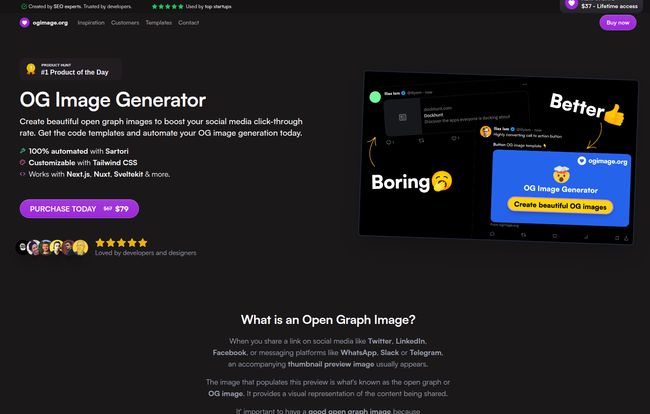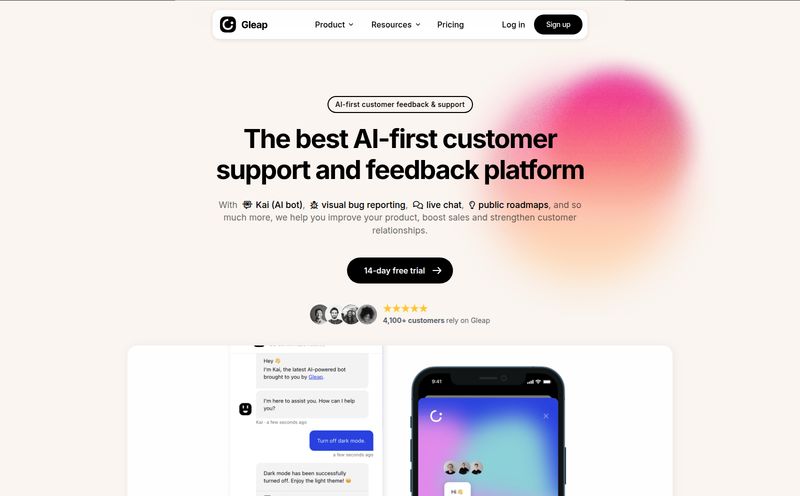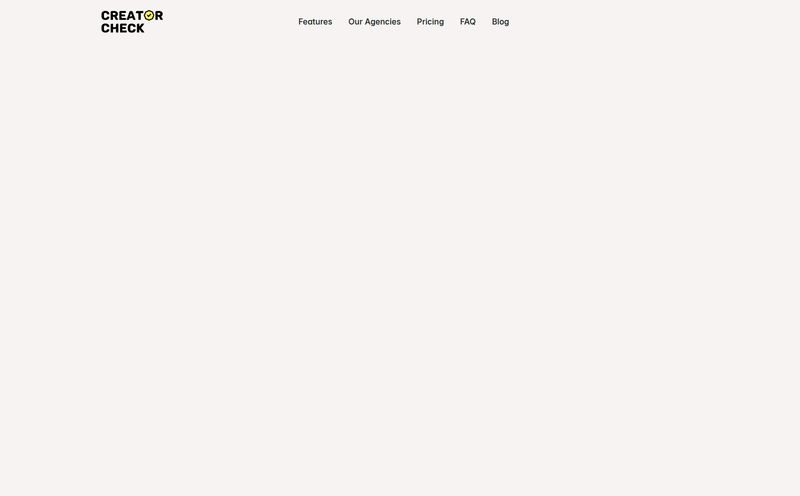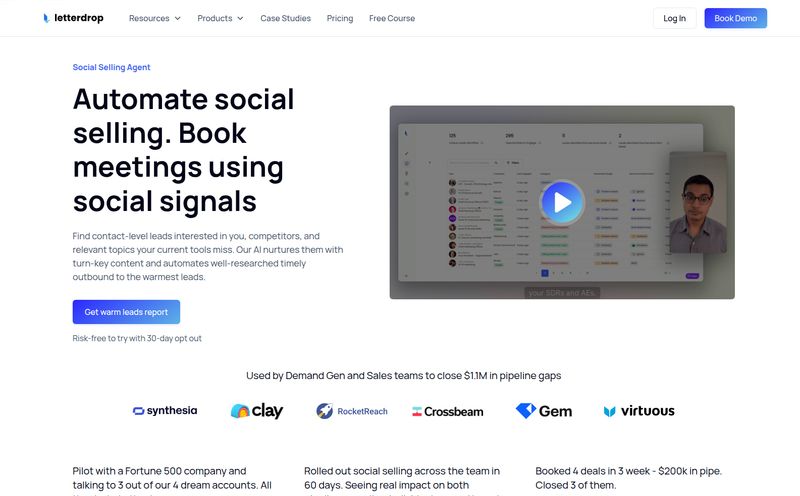You spend hours, maybe even days, crafting the perfect blog post. You pour your heart into the research, the writing, the editing. You hit “publish,” grab the link, and proudly paste it into Twitter or LinkedIn, ready for the world to see your genius.
And what shows up? A horribly cropped, low-res version of your logo. Or worse, some random stock image from halfway down the page. It’s boring. It’s unprofessional. And it gets scrolled past faster than you can say “low click-through rate.”
We've all been there. It’s a frustratingly common problem. That little preview card is your content’s first impression on social media, and most of the time, we’re letting it show up to the party in sweatpants. For years, the fix was a clunky, manual process involving graphic designers, complex image templates, or just crossing your fingers and hoping for the best. It was a pain. A big one.
But recently, I stumbled upon a tool that’s trying to fix this for good, and I’ve gotta say, I’m pretty impressed. It’s called Open Graph Examples, and it’s more than just a gallery of ideas; it’s a full-blown workshop for creating social cards that actually get clicks.
First Off, What Are We Even Talking About?
Before we go further, let's get on the same page. When you share a link, social platforms like Facebook, Twitter, and Slack look for special meta tags in your webpage’s code. These are called Open Graph tags. They're basically little instructions that tell the platform, “Hey, use this title, this description, and this specific image for the preview.”
Think of it as the business card for your webpage. The `og:title` is your name, the `og:description` is your job title, and the `og:image` is your headshot. If you don't define these, the platform just guesses, and it's usually a terrible guesser. The `og:image` is arguably the most important piece of that puzzle. It's the billboard for your content on the noisy highway of social media feeds.
The Art of the Not-Boring OG Image
So, we know the default is often bad. But what makes a good OG image? It’s not just about slapping your logo on a colored background. A great social card is informative and on-brand. It might include:
- The title of the article
- Your brand logo or website name
- An author's headshot (great for personal brands!)
- A compelling background image or pattern
Creating these manually for every single post is a time-suck. And that’s where Open Graph Examples comes into play. It’s built to take this entire process from a chore to a delight.
A Look Inside Open Graph Examples
The OG Image Generator is a Game-Changer
This is the main event. The tool’s OG Image Generator is what really got my attention. It’s not just about uploading an image; it’s about dynamically creating one from beautifully designed templates. You can connect your website, and it can automatically pull in titles, author info, and more to generate these images on the fly. That's right, automated.
The difference is night and day. You go from that sad, boring, auto-generated preview to something that looks like a graphic designer spent 20 minutes on it. But it took you… zero minutes. I’ve seen some great examples in their gallery from sites like Links Report and MagicSpace SEO, and they all look clean, professional, and, most importantly, clickable.
Inspiration and Debugging Tools
Beyond the generator, the platform is a fantastic resource. It has a whole gallery of real-world examples to get your creative juices flowing. Sometimes, just seeing how other successful brands are doing it is half the battle. They also include educational content that explains the nitty-gritty of the protocol, which is a nice touch.
But maybe the most practical feature for us SEO folks is the Open Graph checker. We’ve all used Facebook’s Sharing Debugger a million times, frantically clearing the cache and trying to figure out why our new image won't show. Having a validator built right into the platform where you’re creating the images is just… smart. It streamlines the whole workflow.
So, What's the Catch? Let's Talk Pricing
Alright, this is usually where the dream dies. But right now, they’re offering a lifetime deal (LTD), which is always music to my ears. I’m a huge fan of paying once for a tool I’ll use for years. It just feels like a better investment than yet another monthly subscription draining my bank account.
Here’s the breakdown of their one-time payment plans:
| Plan | Price (One-Time) | Key Features |
|---|---|---|
| Starter | $49 | 1 workspace, 1 user, 10 templates |
| Pro | $99 | 5 workspaces, 5 users, 50 templates |
| Agency | $199 | 25 workspaces, 25 users, unlimited templates |
For a solo blogger or a small business owner, the Starter plan is a no-brainer. For less than the price of a nice dinner, you solve this problem forever. For my money, the Pro plan is the sweet spot for most freelancers, consultants, or small marketing teams. If you’re an agency juggling dozens of clients, the Agency plan is obviously the way to go.
Is it worth it? In my opinion, absolutely. Think about the time saved and the potential upside in clicks and brand perception. It pays for itself very, very quickly.
Final Thoughts
I get excited about tools that solve a specific, nagging problem in an elegant way. Open Graph Examples does exactly that. It takes the tedious, error-prone task of creating social media preview images and makes it simple, automated, and even kind of fun.
It's one of those small tweaks that can have a surprisingly large impact on your traffic and brand. You're already doing the hard work of creating amazing content; don't let a bad preview image trip you up at the finish line. This is a solid tool, and with the lifetime deal on the table, it's a pretty compelling offer.
Frequently Asked Questions
What exactly are Open Graph tags?
They are code snippets inside your website's HTML `` section that control how your content appears when shared on social media. The main ones are `og:title`, `og:description`, `og:image`, and `og:url`.
Why isn't my new OG image showing up on Facebook?
This is a classic! Facebook and other platforms cache (save) this information for a while. To force an update, you need to use a debugging tool, like the official Facebook Sharing Debugger. You paste your URL, and it will “scrape” the new information. The validator in Open Graph Examples helps you check this before you even get to that stage.
Can I use my own brand colors and fonts?
Yes, the generator and its templates are designed for customization. The goal is to create images that are consistent with your brand identity, so you can tweak the layouts to match your specific colors, fonts, and style.
Is Open Graph Examples good for beginners?
I'd say so. It simplifies a somewhat technical topic. You don’t need to be a developer to use the image generator and templates. The educational content on the site also helps bring newcomers up to speed, so it’s a good starting point.
What’s the difference between Open Graph and Twitter Cards?
Great question. They are very similar. Twitter has its own set of tags (`twitter:card`, `twitter:title`, etc.), but if its crawler doesn’t find them, it will fall back and use your Open Graph tags instead. So, by setting your OG tags correctly, you’re already covering your bases for Twitter most of the time.
Is the lifetime deal really a one-time payment?
Yes, based on the information on their site, the pricing shown is for lifetime access. That means you pay once and get to use the tool within the limits of your chosen plan forever. Just be aware that deals like this often don't last forever, so the price could increase or change to a subscription model later on.
References and Sources
- Open Graph Examples - Official Website
- The Open Graph Protocol - Official Documentation
- Facebook Sharing Debugger




